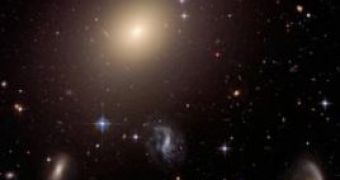Hubble Space Telescope has caught an image of the closest gravitational lens ever found, a huge elliptical galaxy. "The galaxy was well-known, but the Hubble images reveal so much more detail about it, including the unexpected finding that it's the nearest gravitational lens," said John Blakeslee, an assistant professor with the Department of Physics and Astronomy at Washington State University.
A gravitational lens is a space body possessing such an impressive size that it can deflect, magnify and focus light emitted by an object that is on the opposite side of it from the Earth.
That's why - when watched from Earth - the remote galaxy, instead of appearing like a spot or spiral, it looks like an arc or ring, called "Einstein rings", as Albert Einstein was the first to predict their existence. "Despite the huge number of galaxies in the universe, gravitational lensing is a rare occurrence because it requires an almost perfect alignment of a distant galaxy with an intervening one that has enough mass to gravitationally focus the light."
"It's like 'Hubble's Greatest Hits,'" said Blakeslee.
The galaxy, named ESO 325-G004, appears in Hubble's images as a diffuse area of brightness, larger and less defined than other galaxies in the same frame, which have the typical spiral or 'bow-tie' shape. "The galaxy contains several hundred billion stars." said Blakeslee.
The diffuse elliptical appearance of ESO 325-G004 must be determined by the uniform distribution of its stars, in contrast to typical spiral galaxies in which stars gather in curving 'arms' radiating from a central dense zone.
"Its proximity to Earth will allow astronomers to use other techniques, such as spectrographs on ground-based telescopes, to study how fast the stars in the galaxy are moving and estimate how much mass is in the center of the galaxy. With several lines of evidence available to them, astronomers will be able to develop a detailed understanding of the galaxy's structure and behavior", said Blakeslee.
ESO 325-G004 is located just over 450 million light-years from Earth, in the direction of the Centaurus constellation.
Astronomers are now extremely affected by the impairment of the device used to obtain the image, the Advanced Camera for Surveys, in late January when its power system failed.
Photo credit: NASA

 14 DAY TRIAL //
14 DAY TRIAL //